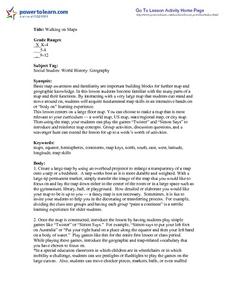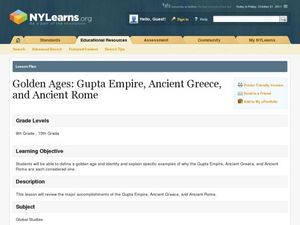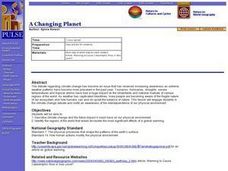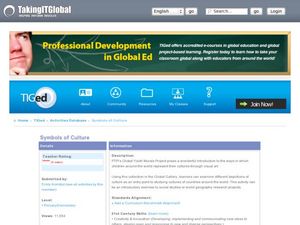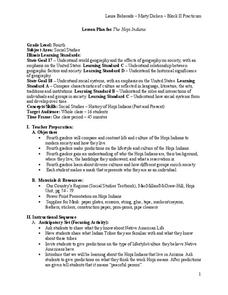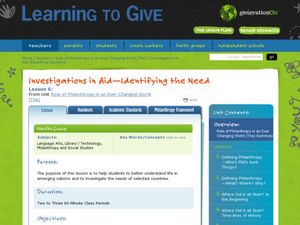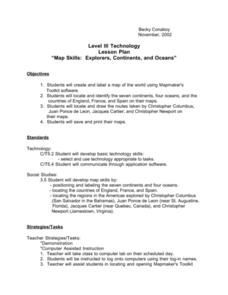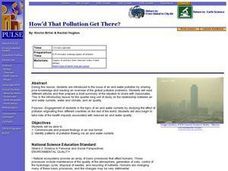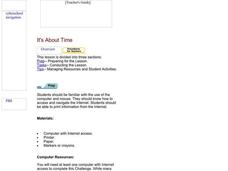Curated OER
Thematic Unit on Cats
Students discover in which climates the cats of the world live in. They review the different climates of the world and use maps and globes to help them locate continents.
Curated OER
Walking on Maps
Students are introduced to the various types of maps and their functions. As a class, they play a game similar to twister to review map concepts. They answer questions about the map and use the internet to view larger maps of the world.
Curated OER
Ancient Cities
Students discuss ways homes, buildings and cities are designed for a particular climate and geography. Students use a chart and conduct library and online research to explore ways the Mayans and Incas developed their land based on their...
Curated OER
Where's the Sand?
Students identify the characteristics of deserts. In this geography lesson plan, students discuss the characteristics of a desert and label a map with the names of deserts.
Curated OER
Golden Ages: Gupta Empire, Ancient Greece, and Ancient Rome
Students investigate the Golden Ages. In this world history lesson plan, students compare and contrast the achievements of the Gupta Empire, ancient Greece, and ancient Rome using an interactive T-chart.
Curated OER
A Changing Planet
Young scholars describe climate change and the future impact it could have on our physical environment. They identify the regions of the world that would encounter the most significant effects of a global warming.
Curated OER
Symbols of Culture
Students discover artistic symbols from cultures around the world. In this cultural murals lesson, students observe different murals on-line, and select two to write about on their student blog. The students investigate the murals and...
Curated OER
The Hopi Indians
Fourth graders make a mask of who they are as an individual after studying the Hopi Indians. In this Hopi Indians lesson plan, 4th graders compare and contrast the Hopi life with theirs, make predictions, and learn about culture.
Curated OER
Investigations in Aid: Identifying the Need
Students investigate the needs in emerging nations. In this emerging nations lesson, students research the conditions for needs in the given countries. Students are assigned to the country groups of Honduras, Nigeria, Bosnia, Cambodia,...
Curated OER
Who Dropped What into the Melting Pot?
Students show the movement of people to the United States from other countries on maps. They study the geographic cultural roots of foods that contribute to the melting pot of food in America. They research where an ingredient comes from...
Curated OER
What And Where is Puerto Rico?: History of Puerto Rico
Young scholars study the history of Puerto Rico. They define what a commonwealth is and how Puerto Rico became a commonwealth of the United States. They research websites for history of Puerto Rico and how it operates today. They...
Curated OER
What Do We Know About Africa?
First graders explore Africa, its geography and climate. After completing a KWL chart, 1st graders locate Africa on a globe and discuss how its location on the earth affects its climate. Using the Internet and a given fact sheet,...
Curated OER
The Carter Center’s Work in Sub-Saharan Africa
Students explore the state of Sub-Saharan Africa. In this geography skills instructional activity, students examine the work of the Carter Center in Africa as they investigate the strengths and weaknesses of linguistic, tribal, and...
Curated OER
Australia
Students discover information about the Aboriginal people of Australia. In this global studies lesson, students listen to mini-lectures regarding the history of Australia and the Aboriginal people. Students compare American Indians to...
Curated OER
Incan Artifacts - Clay Pottery Lesson
Students study Incan artifacts found at an online database and create samples using clay pottery and paint.
Curated OER
The Commonwealth - people and places
Students study the commonwealth as an example of a global community. The study what the Commonwealth is, its values, and its function and they reflect upon personal connections with the Commonwealth. After they investigate their own...
Curated OER
Map Skills: Explorers, Continents, and Oceans
Third graders use a software program to make and label a map of the world. On the map, they locate the seven continents, oceans and the countries of Europe. They also draw the routes of Christopher Columbus, Juan Ponce de Leon and...
Curated OER
Athabaskan Migration & Bering Strait
Young scholars study Athabaskan migration patterns and the Bering Strait Land Bridge theory. They investigate the importance of the expansion of trade and compare the differences between American Indian oral tradition accounts of...
Curated OER
Globe Lesson 17 - Alaska and Hawaii - Grade 4-5
Students develop their globe skills. In this geography skills lesson, students explore the area added to the United States when the Alaskan territory was purchased from Russia.
Curated OER
Cotton Journey
Students use "Cotton Journey-A Field Trip In A Box" kit to relate the significance of cotton to the Civil War period and to study the cotton industry in general.
Curated OER
Environment: How'd That Pollution Get There?
Young scholars examine how global wind and water patterns aid in the spread of worldwide pollution. In groups, they read articles about the domino effect of pollution and create posters displaying its journey. On blank world maps,...
Curated OER
The Sunni/Shia Split in Iraq
Young scholars examine the historic Shia-Sunni conflict to assess its present-day status in Iraq and determine how it might play out in postwar Iraq. In this World History lesson, students research the factors that contribute to the...
Curated OER
Grades 6-8 Lesson Plan - Cities as Transportation Centers
Students examine maps of the 1800's and 1900's. In this geography skills lesson, students collaborate to read core maps and identify transportation centers and travel networks.
Curated OER
It's About Time: Olympics, Winter Sports, Math, Media, Time Zones
Students use the Internet to determine broadcast times for the Winter Olympic Games snowboarding competitions. In determining these times, they need to consider time zones throughout the world.



